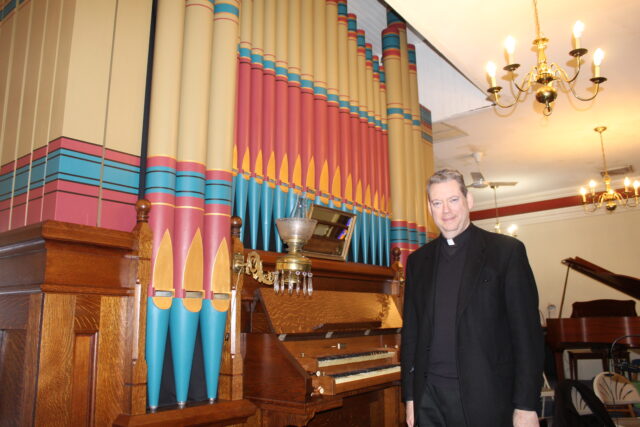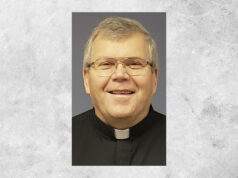
NEW CASTLE — A project that had been on the to-do list at St. Peter the Apostle Parish in New Castle has been completed, and parishioners are liking the sound of that.
The pipe organ in the church, installed 140 years ago, has been completely refurbished and will continue to fill the New Castle church with music for years to come.
Father Tim Nolan, the pastor at St. Peter the Apostle, said to the best of his knowledge, the organ was first installed in 1883. The parish decided during a previous diocesan capital campaign to use the money raised to restore the organ as it showed signs of its age. That was in 2012, and the estimate for repair was around $100,000.
Father Nolan arrived as pastor in 2016, and several fundraisers and donations later, the parish had raised the money necessary. By that time, however, the company they had dealt with previously told the parish the cost would now be closer to $200,000.
After some looking, the parish teamed up with another company, Columbia Organ Works, which is based in Lancaster, Pa. They arrived last May and, over the course of a week, removed the organ from its perch in the loft above the church.
“It took an entire week just to disassemble it,” Father Nolan said. “It’s a highly, highly complex system within there, a series of pipes and levers. There are thousands of pieces within there.”
Elaine Atz, a part-time organist at St. Peter’s for about eight years, said it was time for the work to be done.
“It had two volumes: loud and louder,” Atz said. “It was sticking. There were a lot of problems with ciphering, pipe problems. When it was put in (after the restoration), I couldn’t believe how beautiful it was. Absolutely gorgeous.”
Ciphering is when a note continues to sound after it is supposed to stop.
As it turns out, no matter which company the parish hired to do the restoration, Columbia would have been involved, Father Nolan said, because they are the only firm that manufactures some of the pieces that need to be replaced.
“It’s a wonderful company,” he said. “They very much love what they do.”
The organ is one of the items at St. Peter’s that connects generations at the parish. Founded in 1804, St. Peter the Apostle has been home to more than two centuries of New Castle residents. That’s one of the aspects of the parish that Father Nolan likes.
“It’s the only parish to which I’ve been assigned as a priest that is multigenerational. Every other parish I’ve been assigned to was founded after the Second World War,” he said.
The organ needed two people to operate it into the 1930s, he said. Aside from the organist, there had to be someone to pump air into the bellows. A gauge on the front of the organ indicated when it needed air, and one of the stops would alert the person operating the hand pump. A compressor was added in a closet on the main floor in the ’30s, but it was large and loud. Today, a smaller compressor sits next to the organ.
Part of the restoration included installing new metal fasteners at the bottom of the pipes, where the air enters. Those fasteners had become loose, and without the proper amount of air entering the pipe, “you don’t get the proper sound,” Father Nolan said.
Atz said the organ now connects the 21st century St. Peter’s to its past.
“I imagine it sounds now the way it sounded when it was put in,” she said.
The organ is not as complex as newer ones, she continued. A newer organ might have 30 or 40 stops from which to choose; the one at St. Peter’s has perhaps a dozen. Its keys also may be more difficult to press down than a modern instrument.
As the pipes were refinished by Columbia, workers removed seven layers of paint that had been added over the years. Instead of a solid original color, they found that the pipes were multi-colored, with red and blue stripes and some other decorative artwork. The people of St. Peter the Apostle decided to stay with the original, more colorful look, and that is what they have seen since the organ was returned and reassembled in October.
“The pipes themselves haven’t looked like this probably since the time they were installed,” Father Nolan said.
“The people were delighted. They were quite surprised at how colorful the original colors are.”
That kind of design was made to reflect stained-glass windows, he continued. In the Victorian era, things were much more colorful. Many of the ceilings included artwork, and there was a lot of stencil work on the walls.
Columbia Organ Works finished the restoration in the fall, and the organ was reinstalled over the course of a week in October.
Playing the organ is a skill that amazes Father Nolan. There are two levels of keys, and the organist must use his or her feet as well. On top of that, there are the various stops next to the keyboard that determine how the notes will sound as they come through the pipes.
Atz said it is “mind-boggling” how old the organ is and that it is still in use.
“I would sit there and think, ‘Oh my God, how many fingers have touched these ivory keys?’” she said.
Father Nolan also likes that St. Peter’s continues to use its choir loft. Over the years, lofts in many churches have been abandoned in favor of putting choirs in the front of the congregation, but he likes the loft at St. Peter’s.
“There is something nice when you have the music from behind you. You see in old churches, you do a 360 and you can see something beautiful in every direction,” he said.







